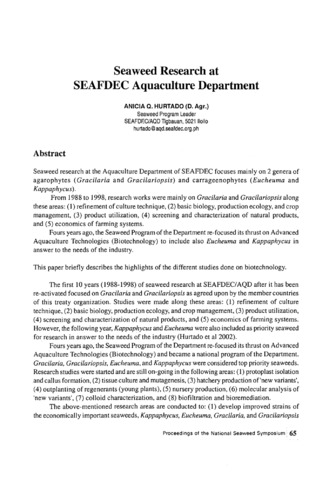Characterization of a virus obtained from snakeheads Ophicephalus striatus with epizootic ulcerative syndrome (EUS) in the Philippines
- Global styles
- MLA
- Vancouver
- Elsevier - Harvard
- APA
- Help

Download URL
www.int-res.comDate
2000Page views
2,535ASFA keyword
AGROVOC keyword
Taxonomic term
Metadata
Show full item record
Share
Abstract
This is the first report of the isolation and characterization of a fish virus from the Philippines. The virus was isolated using snakehead spleen cells (SHS) from severely lesioned epizootic ulcerative syndrome (EUS)-affected snakehead Ophicephalus striatus from Laguna de Bay, in January 1991. The virus induced cytopathic effects (CPE) in SHS cells yielding a titer of 3.02 x 106 TCID50 ml-1 at 25°C within 2 to 3 d. Other susceptible cell lines included bluegill fry (BF-2), catfish spleen (CFS) and channel catfish ovary (CCO) cells. Replication in chinook salmon embryo cells (CHSE-214) was minimal while Epithelioma papulosum cyprini cells (EPC) and rainbow trout gonad cells (RTG 2) were refractory. Temperatures of 15 to 25°C were optimum for virus replication but the virus did not replicate at 37°C. The virus can be stored at -10 and 8°C for 30 and 10 d, respectively, without significant loss of infectivity. Viral replication was logarithmic with a 2 h lag phase; viral assembly in the host cells occurred in 4 h and release of virus occurred 8 h after viral infection. A 1-log difference in TCID50 titer between the cell-free virus and the total virus was noted. Freezing and thawing the virus caused a half-log drop in titer. Viral exposure to chloroform or heating to 56°C for 30 min inactivated the virus. Exposure to pH 3 medium for 30 min resulted in a more than 100 fold loss of viral infectivity. The 5-iododeoxyuridine (IUdR) did not affect virus replication, indicating a RNA genome. Neutralization tests using the Philippine virus, the ulcerative disease rhabdovirus (UDRV) and the infectious hematopoietic necrosis virus (IHNV) polyvalent antisera showed slight cross-reaction between the Philippine virus antiserum and UDRV but established no serological relationship with SHRV and IHN virus. Transmission electron microscopy (TEM) of SHS cells infected with the virus showed virus particles with typical bullet morphology and an estimated size of 65 x 175 nm. The Philippine virus was therefore a rhabdovirus, but the present study did not establish its role in the epizootiology of EUS.
Description
SEAFDEC main author, ISI-CC covered journal. Open Access Journal. Full text available.
Suggested Citation
Lio-Po, G. D., Traxler, G. S., Albright, L. J., & Leaño, E. M. (2000). Characterization of a virus obtained from snakeheads Ophicephalus striatus with epizootic ulcerative syndrome (EUS) in the Philippines. Diseases of Aquatic Organisms , 43(3), 191-198. https://doi.org/10.3354/dao043191
Type
ArticleISSN
0177-5103Collections
- Journal Articles [1258]
Related items
Showing items related by title, author, creator and subject.
-
Seaweed research at SEAFDEC Aquaculture Department
Hurtado, Anicia Q. (Seaweed Industry Association of the Philippines, 2003)Seaweed research at the Aquaculture Department of SEAFDEC focuses mainly on 2 genera of agarophytes (Gracilaria and Gracilariopsis) and carrageenophytes (Eucheuma and Kappaphycus). From 1988 to 1998, research works were ... -
Experimental transmission of epizootic ulcerative syndrome (EUS) in snakehead, Ophicephalus striatus
Cruz-Lacierda, Erlinda R.; Shariff, Mohamed (Fish Health Section, Asian Fisheries Society, 1995)Two separate experiments on transmission of epizootic ulcerative syndrome (EUS) to naive snakehead (Ophicephalus striatus) by cohabitation with EUS-positive snakehead in EUS-enzootic environment and exposure to EUS-enzootic ... -
The hematological changes in snakehead (Ophicephalus striatus) affected by epizootic ulcerative syndrome
Shariff, M.; Cruz-Lacierda, Erlinda R. (Asian Fisheries Society, 1994)Selected hematological parameters were studied in snakehead from Laguna de Bay (Philippines) affected with different stages of epizootic ulcerative syndrome (EUS). For comparison, normal (from a non-endemic area) and ...





